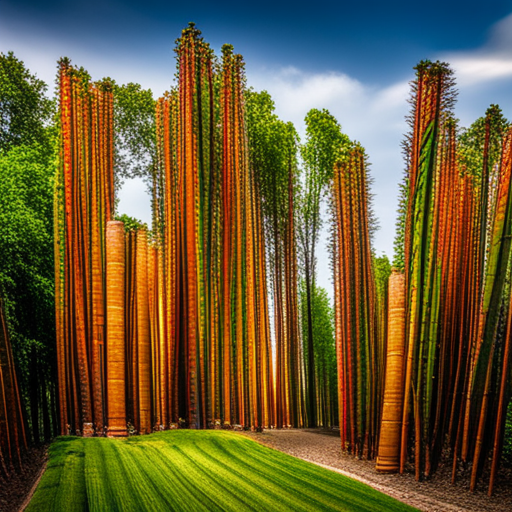Bamboo, with its remarkable versatility and rapid growth, is a plant that has captivated the interest of researchers and enthusiasts alike. This article explores the diverse world of bamboo, focusing on its sizes, uses, and discoveries.
With over 1400 different species, bamboo exhibits a wide range of heights, influenced by factors such as species and growing conditions. The Giant Bamboo stands as the tallest known species, towering up to 30 meters in height, with exceptional clumps reaching an astonishing 42 meters. On the other end of the spectrum, the Raddiella vanessiae, discovered in 2006, is the smallest bamboo species, reaching a mere 2 cm when mature.
Bamboo’s exceptional growth and strength make it a valuable resource with various applications, including construction, paper production, and as a food source. The culms of Giant Bamboo, in particular, possess remarkable versatility, finding use in scaffolding, boat masts, housing, water pipes, furniture, and more. Even bamboo hairbrushes have gained popularity in recent years due to their numerous benefits for hair care.
Despite extensive research, there remain numerous undiscovered bamboo species, especially in remote areas yet to be thoroughly surveyed. The exploration of this diverse world of bamboo holds the promise of uncovering new species and expanding our understanding of this remarkable plant.
Contents
- 1 Our Highlighted Points
- 2 The Sizes of Bamboo
- 3 Uses of Bamboo Culms
- 4 Undiscovered Bamboo Species
- 5 What Are Some Lesser-Known Uses of Bamboo?
- 6 Frequently Asked Questions
- 6.1 What are some common problems or challenges that bamboo plants face when grown outdoors?
- 6.2 What are some specific care requirements for Bissetii Bamboo?
- 6.3 How can non-invasive clumping bamboo be maintained and kept under control?
- 6.4 What are the factors to consider when choosing the right bamboo species for privacy purposes?
- 6.5 Are there any cold hardy bamboo species suitable for Zone 4 climates?
Our Highlighted Points
- Bamboo is the fastest-growing plant in the world, with over 1400 species and a wide variety of sizes.
- The height of bamboo depends on the species and growing conditions, with the tallest known species being Dendrocalamus giganteus, reaching up to 30 meters in height.
- Bamboo has a multitude of uses, including construction, paper production, and as a food source. Giant bamboo culms are particularly versatile and can be used for scaffolding, boat masts, housing, water pipes, vases, buckets, and furniture.
– There are still many undiscovered bamboo species, and bamboo habitats in remote areas have not been adequately surveyed. The recent discovery of Raddiella vanessiae highlights the ongoing exploration and description of new bamboo species.
The Sizes of Bamboo

The size of bamboo plants varies depending on factors such as species, growing conditions, and geographical location.
Bamboo cultivation techniques play a crucial role in determining the height and spread of bamboo plants.
The height of bamboo can range from a few feet to over 100 feet, depending on the species.
Factors affecting the growth of bamboo include plant hardiness zone, in-ground or container planting, heat, water, and wind.
Certain species, like the Giant Bamboo (Dendrocalamus giganteus), can grow up to 40 cm (16 inches) per day and reach heights of 30 meters (98 feet) or more.
On the other hand, Raddiella vanessiae, the smallest known bamboo species, only grows up to 2 cm tall.
It is important to consider these factors and choose the right bamboo species for specific growing conditions and desired size requirements.
Uses of Bamboo Culms

Bamboo culms serve multiple purposes, including construction, paper production, and as a food source. When it comes to construction, bamboo culms are highly regarded as a sustainable building material due to their strength and flexibility. They have been used for centuries in the construction of houses, bridges, and even skyscrapers.
In arts and crafts, bamboo culms are widely used for their aesthetic appeal and versatility. They can be carved into intricate designs, woven into baskets and mats, and used as decorative elements in furniture and home decor.
Additionally, bamboo culms are also a source of food in many cultures, with young shoots being harvested and consumed for their nutritional value.
Overall, the diverse uses of bamboo culms highlight their importance as a renewable and versatile resource.
Undiscovered Bamboo Species

Undiscovered bamboo species continue to hold potential for expanding our knowledge of plant diversity and contributing to the ever-growing field of botanical research. Despite the extensive cataloging of bamboo species, there are still many species that remain undiscovered and undescribed. Bamboo conservation efforts are crucial to protect these unknown species and their habitats. Proper identification and documentation of these species are essential in order to understand their ecological roles and potential uses. Bamboo species identification can be challenging due to their morphological similarities and the lack of comprehensive surveys in remote bamboo habitats. To provide a visual representation of the diversity of undiscovered bamboo species, a 3 column and 5 row table is presented below:
| Species Name | Geographic Distribution | Habitat |
|---|---|---|
| Species 1 | TBD | TBD |
| Species 2 | TBD | TBD |
| Species 3 | TBD | TBD |
| Species 4 | TBD | TBD |
| Species 5 | TBD | TBD |
This table highlights the need for further exploration and research in bamboo habitats to uncover and describe the countless undiscovered bamboo species.
You may also like to read more about growing bamboo in USDA Zone 6.
What Are Some Lesser-Known Uses of Bamboo?
Bamboo gardens in the USA offer a range of lesser-known uses of bamboo. Apart from its obvious aesthetic appeal, bamboo proves to be an excellent building material due to its durability and sustainability. Additionally, bamboo shoots are a delicious culinary treat, often used in Asian cuisine. Moreover, bamboo’s versatility extends to crafts, furniture, and even textiles, providing an eco-friendly alternative.
Frequently Asked Questions
What are some common problems or challenges that bamboo plants face when grown outdoors?
Common problems or challenges that bamboo plants face when grown outdoors include bamboo cultivation issues such as root rot, fungal diseases, pest infestations, and inadequate soil conditions. These factors can affect the growth and health of bamboo plants.
What are some specific care requirements for Bissetii Bamboo?
Bissetii bamboo care requirements involve providing adequate sunlight, well-drained soil, and regular watering. Effective pruning techniques include removing dead or damaged culms, thinning out overcrowded areas, and shaping the plant.
How can non-invasive clumping bamboo be maintained and kept under control?
To maintain and control non-invasive clumping bamboo, pruning techniques can be employed. Regular pruning of the rhizomes and removal of unwanted culms can help restrict its spread and maintain its desired size within a designated area.
What are the factors to consider when choosing the right bamboo species for privacy purposes?
When choosing a bamboo species for privacy purposes, factors to consider include climate suitability and growth rate. Common problems for outdoor bamboo plants are invasive spread, pests, and diseases. Specific care for bissetii bamboo includes regular pruning and well-drained soil. Maintenance of non-invasive clumping bamboo involves installing rhizome barriers and regular thinning. Cold hardy bamboo species suitable for zone 4 climates include Phyllostachys bimboensis and Fargesia rufa.
Are there any cold hardy bamboo species suitable for Zone 4 climates?
Cold resistant varieties of bamboo are suitable for zone 4 climates. Some of the best bamboo species for colder climates include Phyllostachys bissetii, Fargesia robusta, and Phyllostachys nigra. These varieties can tolerate freezing temperatures and provide privacy in colder regions.

